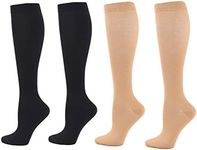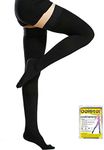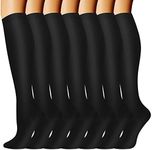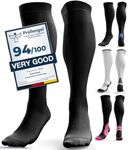Buying Guide for the Best Medical Compression Socks
When choosing medical compression socks, it's important to understand that they are designed to improve blood flow, reduce swelling, and prevent blood clots. They are often recommended for people with certain medical conditions, those who stand or sit for long periods, or athletes looking to enhance performance and recovery. The right pair of compression socks can make a significant difference in comfort and health, so it's crucial to consider several key specifications to ensure you select the best fit for your needs.Compression LevelCompression level refers to the amount of pressure the socks apply to your legs, measured in millimeters of mercury (mmHg). This is important because different levels of compression are suitable for different needs. Light compression (8-15 mmHg) is often used for mild swelling or tired legs, moderate compression (15-20 mmHg) is suitable for travel or mild varicose veins, and firm compression (20-30 mmHg) is typically recommended for more severe conditions like deep vein thrombosis or severe varicose veins. To choose the right compression level, consider your specific health needs or consult with a healthcare professional.
MaterialThe material of compression socks affects comfort, breathability, and durability. Common materials include nylon, spandex, and cotton blends. Nylon and spandex offer good elasticity and durability, making them suitable for everyday wear and athletic activities. Cotton blends provide more comfort and breathability, which can be beneficial for sensitive skin or warmer climates. When selecting material, consider your skin sensitivity, the climate you live in, and how long you plan to wear the socks each day.
Size and FitSize and fit are crucial for the effectiveness of compression socks. They need to fit snugly but not too tight, as improper fit can lead to discomfort or reduced effectiveness. Sizes are usually determined by measuring the circumference of your ankle, calf, and sometimes thigh, as well as the length of your leg. It's important to follow the sizing chart provided by the manufacturer to ensure a proper fit. Consider your leg measurements and any specific fit preferences when choosing the right size.
LengthCompression socks come in various lengths, including knee-high, thigh-high, and full-length (pantyhose style). The length you choose should be based on the area of your leg that needs support. Knee-high socks are suitable for most people and are easier to put on, while thigh-high or full-length options may be necessary for more comprehensive support or specific medical conditions. Consider the area of your leg that requires compression and your comfort preferences when selecting the length.
Style and ColorWhile style and color may seem like minor considerations, they can impact your willingness to wear the socks regularly. Compression socks are available in a variety of styles, from plain and professional to colorful and patterned. Choosing a style and color that you feel comfortable and confident wearing can encourage consistent use, which is important for achieving the desired health benefits. Consider your personal style and the occasions you plan to wear the socks when making your selection.
















